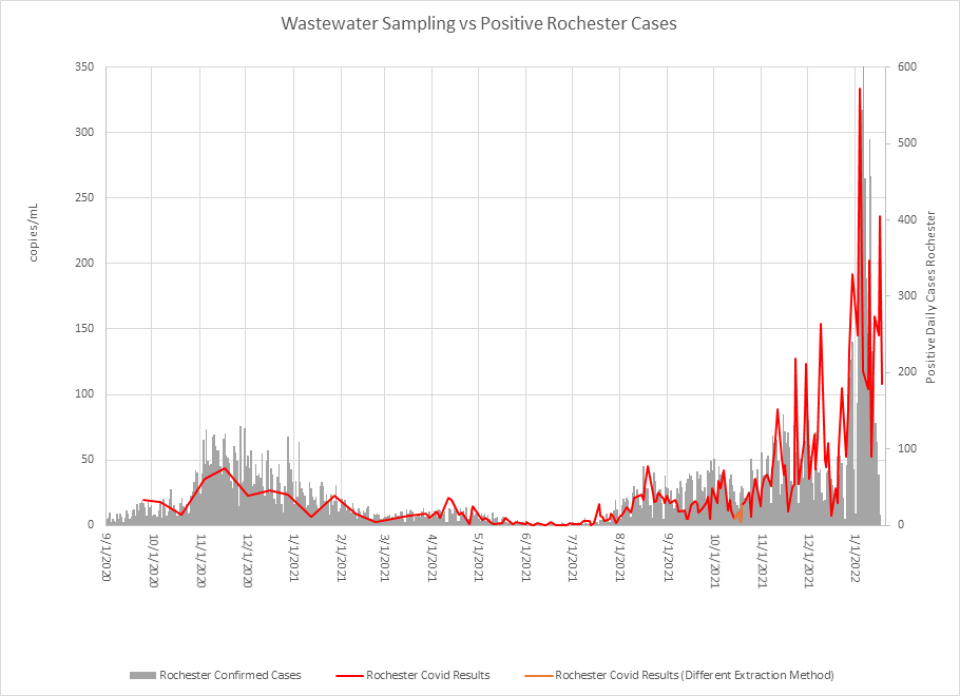Wastewater monitoring of COVID-19
Authored By: dies0044 01/31/2022Story originally published in the Olmsted County COVID-19 newsletter - January 27, 2022
Wastewater from communities is collected by wastewater systems and transported to wastewater treatment plants. Participating utilities collect samples of untreated wastewater or primary sludge. These samples are sent to environmental laboratories for COVID-19 testing. The testing data is submitted to participating health agencies. Health agencies submit these data to the CDC. The CDC analyzes the data in real time and reports results to health departments for use in their COVID-19 response.
City of Rochester wastewater monitoring
 The human body sheds remnants of a COVID-19 infection before it begins to show symptoms. When someone has COVID-19, their body is shedding coronavirus RNA. This molecule, which acts like a fingerprint, can be found in the body’s waste. Because this molecule is detectable in human waste 3-8 days before someone can get tested, scientists can monitor wastewater to help forecast future COVID-19 cases and identify locations where the virus may be spreading. As seen in the graph below, the presence of coronavirus RNA in wastewater closely parallels the cases of COVID-19 reported by testing clinics.
The human body sheds remnants of a COVID-19 infection before it begins to show symptoms. When someone has COVID-19, their body is shedding coronavirus RNA. This molecule, which acts like a fingerprint, can be found in the body’s waste. Because this molecule is detectable in human waste 3-8 days before someone can get tested, scientists can monitor wastewater to help forecast future COVID-19 cases and identify locations where the virus may be spreading. As seen in the graph below, the presence of coronavirus RNA in wastewater closely parallels the cases of COVID-19 reported by testing clinics.
Since September 2020, the City of Rochester, Mayo Clinic and the University of Minnesota Rochester (UMR) have used wastewater to monitor the presence of COVID-19 in the community. This innovative and collaborative initiative between community partners has created another tool to help leaders gauge the prevalence of COVID-19 within the Rochester community. This tool is unique in that it is actually a predictor of cases to come. Additionally, it has become even more useful as home testing has become more common, making tracking cases even more difficult. Testing will continue through at least 2023 to monitor COVID-19 within the community.
Each partner has a key role in this joint project. The City of Rochester collects the wastewater samples and prepares them using a separator. The samples are then sent to Mayo Clinic. Mayo Clinic extracts RNA from wastewater in order to detect how much COVID-19 is present. UMR provides a lab technician to assist the lab work at Mayo Clinic. Olmsted County provides oversight and financial support. The data is shared with all parties and is reviewed for accuracy and compared with positive case numbers to determine trends.
The nature of the collection process (creating a composite sample by collecting a small amount of wastewater approximately every 6 minutes over a 24-hour period) allows the entire population of Rochester to be reflected in just one sample. This past summer, the Cities of Byron and Stewartville also began providing wastewater samples for a more holistic regional perspective. The data from this monitoring process is a useful predictive tool to aid in public health decision-making, especially now that home testing kits are readily available and fewer people are utilizing test clinics that report positive cases to local Public Health.